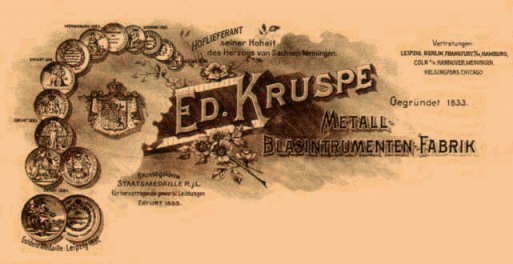| Gli strumenti musicali a fiato in ottone di alta qualità sono stati fatti a mano per oltre 175 anni dalla società Ed. Kruspe.
Il nome Kruspe è già menzionato nelle prerogative della città di Erfurt dal 1530.
Carl Kruspe rilevò il laboratorio di Erfurt nel 1833 dal suo maestro e maestro, il costruttore di strumenti Karl Zielsdorf.
Insieme ai suoi due figli, Eduard e Friedrich, Carl Kruspe ha creato l'officina, specifica per gli strumenti a fiato in ottone, che in seguito sarebbe diventata famosa in tutto il mondo. Quando l'azienda è stata fondata sulla vasta gamma di strumenti a fiato in metallo comune, il corno, lo strumento orchestrale più difficile, ha sempre ricevuto un'attenzione particolare nella sua costruzione e nella sua esecuzione artistica.
Nel 1864 Eduard Kruspe divenne il proprietario del laboratorio del padre.
Eduard Kruspe si ritirò dagli affari quotidiani nel 1893 e suo figlio Fritz rilevò la compagnia. Rimase vicino alla compagnia e continuò a sviluppare nuovi modelli.
Con eccezionale talento artistico e straordinarie capacità, ha consolidato la buona reputazione acquisita nel frattempo dagli strumenti musicali Kruspe.
I figli di Eduard Kruspe, Fritz e Walter, svilupparono il primo (utilizzabilo) doppio fa-sib nel 1897; in questa prima corno doppio con valvole a due piani, la società Kruspe ha registrato il proprio nome il 05.10.1897, la protezione del modello di utilità. Nel 1904, un doppio clacson con corno fa e sib separata fu sviluppato in stretta collaborazione con il noto suonatore di corno Anton Horner, Philadelphia [PA]. Il modello "Horner" è ancora in produzione oggi.
Fritz Kruspe morì nel 1909 e la sua vedova si prese cura della compagnia.
Nel 1920 la direzione dell'azienda fu trasferita al prof. Georg Wendler, genero di Eduard, che aveva una cattedra per corno con la Boston Symphony Orchestra per venti anni e insegnò per sedici anni come professore per Horn al New England Conservatorium a Boston [MA] USA.
Rudi Schneider è entrato a far parte dell'azienda nel 1936 e ha imparato a creare strumenti musicali da Fritz Kruspe. Le condizioni per la società peggiorarono sempre più dopo il 1945. In particolare, l'acquisto di materiali è diventato sempre più complesso, a causa del quale difficilmente è stato possibile creare nuovi strumenti musicali. Nel 1956 ha rilevato il laboratorio e ha continuato la compagnia tradizionale. Il signor Schneider era l'unico maestro artigiano che lavorava in questa compagnia da venti anni.
Peter Heldmann è stato il proprietario dell'azienda negli anni a partire dal 1979, fino alla sua pensione alla fine dell'anno 2011. Ha inoltre completato il suo apprendistato e l'addestramento per allievi nella famosa compagnia.
Dall'autunno 2012 fino alla primavera 2018 l'attività è proseguita da Tatehiko Sakaino. Ha completato i suoi studi presso l'Università di Belle Arti di Tokyo / Giappone e successivamente anche con Erich Penzel presso la Staatliche Musikhochschule di Colonia / Germania. Ha lavorato come suonatore di corno per la Tokyo Philharmonic Orchestra e la Tokyo Metropolitan Symphonic Orchestra, in seguito anche in orchestre in Germania (ad esempio in Baden-Baden, Bad Kissingen e Hof / S.).
Dall'aprile 2018 Katsushi Sakaino è responsabile della gestione e della produzione. Nato a Garmisch-Partenkirchen, in Alta Baviera, ha completato i suoi studi in economia aziendale e poi ha iniziato a lavorare nel dipartimento QM in una società IT. Ha poi colto l'occasione per imparare gli strumenti musicali di P. Heldmann e ha lavorato per oltre quindici anni come costruttore di strumenti musicali.
Oltre ai tradizionali modelli Kruspe "Leipzig", "Wendler", "Horner" e "Walter Kruspe", altri nuovi modelli sono realizzati con la comprovata qualità Kruspe. Tutte le corna della compagnia Ed. Kruspe ora è disponibile in ottone, alpacca e ottone dorato. Opzionalmente, le corni possono anche essere ordinate con una campana staccabile.
Lo sviluppo delle trombe della compagnia Kruspe fu influenzato da Richard Stegmann; anche le trombe prodotte oggi si basano sul modello Stegmann, nonostante un ulteriore sviluppo. D'ora in poi, le trombe, disponibili nell'umore sib e in do, sono disponibili anche con lembi di intonazione e trigger per il primo o il terzo movimento.
*) Le foto sono gentilmente fornite dall'ex proprietario dell'azienda P. Heldmann.
| 




